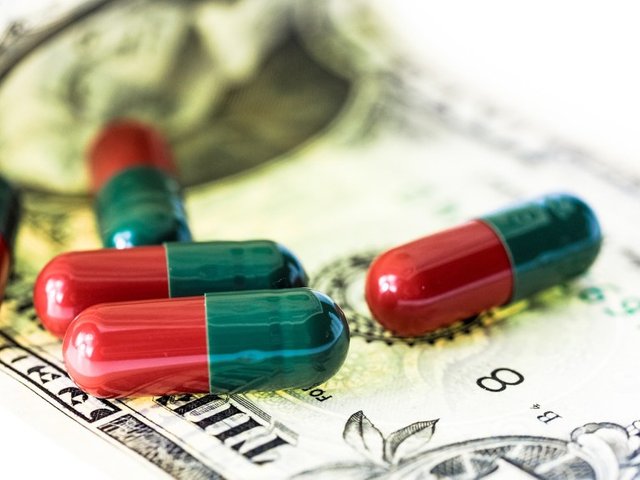Goldman Sachs and the Economics of Curing Disease

Image source: foodmed.net
Does curing disease represent a sustainable business model?
That issue was recently analyzed by Goldman Sachs analyst Salveen Richter and her colleagues in the report “Genome Revolution”, as reported by CNBC’s Tae Kim:
"The potential to deliver 'one shot cures' is one of the most attractive aspects of gene therapy, genetically-engineered cell therapy and gene editing. However, such treatments offer a very different outlook with regard to recurring revenue versus chronic therapies," analyst Salveen Richter wrote in the note to clients Tuesday. "While this proposition carries tremendous value for patients and society, it could represent a challenge for genome medicine developers looking for sustained cash flow."
Source: CNBC
Richter and her team reference a case study of treatments offered by Gilead Sciences for hepatitis C, which attained cure rates of over 90 percent. U.S. sales for the company’s treatments reached $12.5 billion in 2015, but have been falling since and are expected to drop below $4 billion this year. Richter notes:
GILD is a case in point, where the success of its hepatitis C franchise has gradually exhausted the available pool of treatable patients," the analyst wrote. "In the case of infectious diseases such as hepatitis C, curing existing patients also decreases the number of carriers able to transmit the virus to new patients, thus the incident pool also declines … Where an incident pool remains stable (eg, in cancer) the potential for a cure poses less risk to the sustainability of a franchise.
Source: CNBC
What's the Solution?
The report does offer three potential solutions centered around taxing corporate profits earned from medical treatments researching treatments that will have the maximum impact on the company’s bottom line:
"Solution 1: Address large markets: Hemophilia is a $9-10bn WW market (hemophilia A, B), growing at ~6-7% annually."
"Solution 2: Address disorders with high incidence: Spinal muscular atrophy (SMA) affects the cells (neurons) in the spinal cord, impacting the ability to walk, eat, or breathe."
"Solution 3: Constant innovation and portfolio expansion: There are hundreds of inherited retinal diseases (genetics forms of blindness) … Pace of innovation will also play a role as future programs can offset the declining revenue trajectory of prior assets."
Source: CNBC
Reading between the lines, it seems like these solutions could be reframed as follows:
"Avoid researching treatments for rare diseases (which may only be profitable at price points that exceed patients’ purchasing power based on the small market size) for treatments addressing larger, more stable markets that will yield the greatest cash flow."
This approach appears logical from a business perspective and seems to align with the tenets of capitalism. But is there more to this issue?
Summary
Although Goldman's report does not suggest that companies should cease developing one-shot cures, it does seem to imply that such treatments may not be profitable in the long run. If that's the case, how should companies manage treatments that could have a life-altering impact on only a few patients?
It seems that Richter and her team are addressing an issue that affects not only gene therapy, but all medical therapies supported and provided by profit-driven entities - from medicine to procedures to preventative care: if companies prioritize profits over people, what will be the impact on human lives?
What do you think?
How should treatments for rare diseases with a small patient profile be addressed? Should research be publicly funded? Should it fall to smaller private entities?
Should companies be able to profit off the sick?
Publicly traded pharmaceutical and biotech companies have a fiduciary duty to act in the best interest of shareholders. Do they also bear a responsibility to society based on their function and expertise? How should they balance these two priorities?
Should the development of medical treatments be driven by profits or the utilitarian principle of helping the greatest amount of people? If driven by utilitarianism, how do we develop a system under the framework of capitalism that incentivizes corporations to invest in treatments with low ROI?
Gene therapy bears high R&D costs, estimated to be between $500K and upwards of $1M, but as the Washington Post notes, the success of gene therapy treatments is not guaranteed and can even lead to death in some instances. How do we balance paying for a life-changing treatment that may not work and could cost at least hundreds of thousands of dollars?
How do corporations in general balance profits and contributions that promote social welfare? Is capitalism compatible with general human prosperity?
Please share your thoughts in the comments below!
If you enjoyed this article and would like to see similar articles in the future, please support and follow @factotumk. Thanks for reading!
Resources and Further Reading
Goldman Sachs Analysis
Kim, Tae, CNBC, “Goldman Sachs asks in biotech research report: 'Is curing patients a sustainable business model?'”
Mole, Beth, Ars Technica, “Is curing patients a sustainable business model?” Goldman Sachs analysts ask”
Einenkel, Walter, Daily Kos. “It finally happened: Goldman Sachs asks 'Is curing patients a sustainable business model?'”
Doctorow, Cory, BoingBoing, “Goldman Sachs report: "Is curing patients a sustainable business model?"”
Woolfe, Sam, The Canary, “New revelations from an investment bank show the danger private companies pose to our health”
Gene Therapy
Regalado, Antonio, MIT Technology Review, “When curing a disease with gene therapy is bad business”
Mullin, Emily, MIT Technology Review, “Tracking the Cost of Gene Therapy”
FDA, “What Is Gene Therapy? How Does It Work?”
Lewis, Ricki, Genetic Literacy Project, “Gene therapy challenge: How much should it cost and how do we pay for it?”
Dennis, Brady and Carolyn Y. Johnson, Washington Post, “Gene therapies offer dramatic promise but shocking costs”